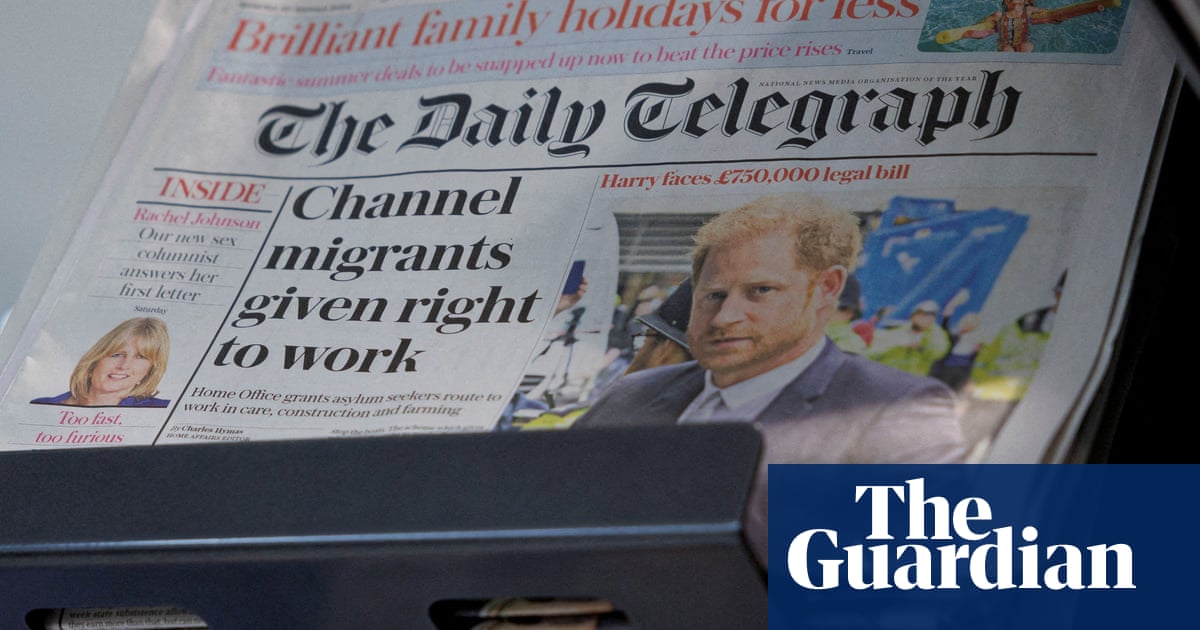
In July 2018, the peace of an upmarket cul-de-sac in rural Hampshire was suddenly disturbed by the arrival of two police officers and three people from trading standards banging on the door of a big redbrick house. They had a warrant to carry out what was called an “inspection”, but was really a raid.
The man they were investigating was 50-year-old Richard Hutter, and the job they had to do that day took three hours. As they searched his home, he spent most of the time in the kitchen, insisting that he had done nothing wrong. His mood was one of shock and deep discomfort. For at least six years, he had quietly sold his wares online and funded an apparently affluent lifestyle to the tune of around £1.2m; now, the consequences were coming home.
The raid turned up less evidence than the people involved would have liked, but enough to form the kernel of a case. They found one vinyl copy of Songs for the Deaf by Queens of the Stone Age, and 13 of Ænima, the 1996 album by the California alternative metal band Tool, as well as 18 outer and inner sleeves of the same record. Investigators also found “a big book, like an encyclopedia of vinyl with details of records’ values”, along with a handful of business cards from people involved in buying and selling vinyl records.
The biggest finds were on a mobile phone that was seized: WhatsApp messages mentioning album artwork, and downloads of original recordings. Hutter had also been careless enough to take detailed pictures of what seemed to be his HQ: an anonymous-looking office, with oatmeal-coloured carpets, Ikea-style shelving, a solitary desk and computer, and boxes and boxes of vinyl albums.
He had taken a solitary selfie, with records lined up behind him. Other photos showed stacks of albums by artists such as the Beatles, Pink Floyd and Amy Winehouse, which were what collectors would instantly identify as bootlegs: illicit collections of unreleased material, not found in those artists’ official bodies of work. But plenty of others seemed to highlight Hutter’s apparent speciality: counterfeit versions of official albums – from Blonde by the eclectic American artist Frank Ocean, to the Eagles’ live album Hell Freezes Over – sold to people who he clearly assumed wouldn’t know the difference.
Before he started selling records, Hutter had worked as a solar-panel salesman. His latest business was called Vinyl Groove UK. Where it was based was a mystery: when he was asked about what was in the photos, he said the premises they showed were in the Netherlands, where his father lived. This claim, unfortunately, underlined the sense of someone who was not quite a criminal mastermind: on close inspection, the pictures showed British three-pin plug sockets.
Vinyl has become known as the music format that came back from the dead; its renaissance has spawned a growing criminal industry
Wherever they were shipped to his customers from, the records were sold on eBay and the music-focused platform Discogs. Among the vast array of albums Hutter had been caught trading were blue vinyl copies of Nirvana’s Nevermind and a red edition of Guns N’ Roses’ Appetite for Destruction, as well as Pearl Jam’s Vitalogy, the Clash’s London Calling, and two records by AC/DC. One was 1976’s High Voltage; the other, poetically enough, was the same year’s Dirty Deeds Done Dirt Cheap.
The case finally came to court in the spring of last year, in Bournemouth. As everyone involved well knew, Hutter was one small but significant part of a global trade in illegal records. Over the last decade, vinyl has become known as the music format that came back from the dead: now, its renaissance has spawned a criminal industry that seems to be growing bigger by the month.
Following the illegal vinyl trade – and the work of the people trying to stop it – can be both fascinating and very strange. The stories it produces mix mundane law enforcement with the names of hugely famous musicians.
Four months ago, for example, I learned of a new investigation called Operation Typhoon, which was initially focused on a city in the Midlands. No one involved could say much about it, but parts of the story seemed familiar: the involvement of both the police and local trading standards officers, more records by Frank Ocean, and bone-dry announcements of each new discovery. “Intelligence will be shared with all the relevant parties, nationally and internationally,” said one official statement, “to locate the source of manufacture so that further action can be taken.”
All I knew at first was that 529 records had been seized after a visit to another online business, and put into thick, clear polythene sacks, ready for forensic analysis. But then, early in the morning of 20 February, there was an apparent breakthrough.
In one police raid, 5,000 albums with a street value of £1m were discovered
The latest raid had been carried out by the City of London police on “a three-storey industrial unit in west London”. What had been discovered included 5,000 albums (along with “inlay sleeves” and “disc centre labels”), by such artists as Kanye West and Drake, as well as old-school rappers De La Soul and Eric B & Rakim. The accompanying police statement said that the total street value of what had been seized was estimated at £1m. One man had been arrested, and then released under investigation.
Illicit vinyl has been in circulation for as long as records themselves, but they last reached a peak of production between the mid-1960s and late-70s (circa 1964, counterfeit versions of the million-selling American album Introducing … the Beatles were reckoned to have outsold the official edition by three to one). Then, as now, what was produced often followed a predictable pattern: if an album by a successful artist was in short supply, ideally to the point of being considered collectible, then piracy would fill the gap.
The same period saw the advent of so-called bootleg albums. That story is usually reckoned to have begun with a collection of unreleased Bob Dylan recordings unofficially titled Great White Wonder, put out in July 1969 by two residents of Los Angeles whose operation was rather archly known as Trademark of Quality. For the next 30 years or so, bootleg and counterfeit records – along with cassettes and videotapes – formed an enduring but small part of the record market. But the advent of the CD caused a much bigger problem: the new format proved to be so easy to duplicate and manufacture that counterfeit CDs of huge-selling albums amounted to a massive industry, with the involvement of organised crime. In 2001, in fact, two out of every five music recordings sold worldwide were reckoned to be illegal copies.
Streaming now accounts for 83% of British music consumption, and has led to seemingly booming times for the UK music industry: last year, it reported its eighth consecutive year of rising revenue from recorded music. Against that backdrop, the new wave of vinyl piracy might look very small. But old-fashioned records are part of the music industry’s unexpected revival: in 2022, 5.5m vinyl albums were sold in the UK alone, and in the first six months of 2023, their sales were up 12% year on year. And there lies the counterfeiters’ great opportunity.
As music companies stoke demand for old-fashioned LPs, the world’s production capacity lags behind. Until around 10 years ago, the industry was dependent on a finite stock of pressing machines that were more than 30 years old; then, in 2015, new equipment started to ease the pressure. But there is still a big gap between supply and demand. Albums regularly disappear from shops and online platforms, awaiting re-pressing; the delays between ordering and getting new records can last up to six months. Worse still, though the vinyl renaissance initially saw record buyers paying about £25 for the average new album, prices are now creeping into the 30s and 40s. Among music obsessives, moreover, there is a newly energised market not just for ordinary albums but also bootlegs (of live recordings, radio sessions and studio “out-takes”), as well as the kind of rarities that can be easily faked.
In the UK, British Phonographic Industry (BPI), the umbrella group that speaks for record labels, employs a small team of people who monitor the illegal sale of music, and do their best to stamp it out. In BPI’s view, it is “a serious crime that denies artists the rewards for their creativity, exploits fans, and impacts legitimate retail and the record labels that invest in music”. It also points out that the trade in illicit records sometimes blurs into money laundering and drug dealing. Between 2020 and 2022, BPI says it removed 43,000 fake records from online marketplaces, with a crudely estimated value of £860,000: factor in the tens – or even hundreds – of thousands of albums that presumably went unspotted and you get a sense of the mushrooming shadow industry that is trying to tackle.
When I talk to two vinyl specialists from BPI’s content protection unit – I’ll call them David and Paul – they explain that because they spend some of their time quietly visiting shops and record fairs, they have to remain anonymous. The kind of expertise the job requires is obvious. On first sight, I would take them to be the sort of middle-aged, music-loving men who spend their weekends happily immersed in their buying and listening habits: by way of breaking the ice, one of them talks knowledgably about the hugely influential British band Talk Talk, while the other enthuses about his interest in reggae and ska.
They reckon that 50% of the work they do is now focused on vinyl. Some record shops, David tells me, will have up to 5% “counterfeit or bootleg content”, which they accept as an unalterable fact of life. “It’s like speeding – quite a few people do it, and you can’t catch everybody on a given day.” When the proportion starts to exceed 20%, “then that’s when we start to get really interested”.
BPI often starts investigations by doing test purchases online of albums that look suspect. Routine giveaways include fuzzy artwork, blurred text and inconsistent matrix numbers etched into albums’ run-out grooves. If records turn out to be either bootleg or counterfeit, they will demand that the platforms concerned remove them – before, in some cases, approaching local trading standards officers or the police about taking more drastic action. At the same time, they are constantly piecing together information about where illegal records might be being manufactured, and how they are making it into the UK.
As the Hutter case proved, there is a particularly huge trade in coloured vinyl versions of albums and picture-discs, some of which sell for mind-boggling prices. “Last year, we discovered 12-inch picture-discs that were single-sided,” says Paul. “They were originating from Israel. They had a caricature-type picture on the front of the artist. We found about 500 of these. If it was by Dire Straits, it’d be Money for Nothing – one of their biggest hits, just the A-side on a single-sided 12-inch disc. But these were selling for around $300.”
Some hugely popular albums have never made it to vinyl – which creates another opening for pirates. “Beyoncé’s 4 never came out in that format,” says David. “Frank Ocean’s Channel Orange is another classic example: we see a lot of those.” The images of Hutter’s office show a stack of Channel Orange records, along with copies of Blonde, which was put out on vinyl in extremely limited quantities, before being reissued in 2022.
Most of the vinyl, BPI says, comes from countries in the EU. Do they come across legitimate-looking manufacturers that outwardly restrict themselves to official albums and singles, but press up pirate records when no one is looking? That, I am told, “isn’t common, but it certainly happens”. The majority of illegal albums, it seems, are done “underground”, in “very dirty and haphazard environments”. Given that such conditions make for shoddily presented and lousy-sounding records, that often makes the spotting of counterfeits all the easier.
Past prosecutions of illegal vinyl specialists have involved pressing plants in the UK, Italy and the Czech Republic. BPI says it is now putting together a case that involves “intelligence from a Spanish national about an Italian counterfeiter who’s pressing in Germany, and banking in Portugal”. Records, labels and sleeves are often transported around Europe. The same is even true of “stampers”, the metal negatives used when a particular record is pressed.
“About 10 years ago,” says Paul, “I raided a pressing plant in this country. We thought there was nobody there. It was quite early in the morning: the police forced entry, and there were two German nationals fast asleep in the control room. They’d brought some stampers over from Germany and were using the premises in the UK to press 12-inch bootlegs, and take them back that morning. So they got nicked, as did the owner.”
A few weeks after I hear that story, BPI’s press department sends me a top 10 list of the artists whose bootleg and counterfeit albums have been most frequently removed from online platforms (or “delisted”). The No 1 position, somewhat surprisingly, is held by the veteran goth outfit the Sisters of Mercy, with 695 delistings. Then comes David Bowie, the Rolling Stones, Joy Division and Pink Floyd – followed by the Cure, the Clash, Led Zeppelin, Motörhead and Iron Maiden. Their names are followed by a curt explanation: “You may notice that most of these artists are heritage acts from rock genres. The production of counterfeit vinyl is driven by demand, and this is what is selling.”
Richard Hutter, who seems to go by the name Rick, based a lot of his business on artists like these. Biographical material I find about him online says he has a master’s degree in economics from Vrije University in Amsterdam, and speaks English, Dutch and German. When I email him, he replies 12 hours later: “How am I going to be portrayed in the story – villain or victim of miscarriage of justice, as they could not take eBay to court?”
The logic of that claim seems questionable, to say the least: eBay takes precautions to stop counterfeit goods being sold and its terms and conditions specify that sellers are responsible for the legality of what they sell. Still, I send a reply to Hutter saying that if that’s what he wants to say, it can be included in what I write, and we make arrangements to speak on the phone. But he then backs out. “After having discussed this with my family,” he says, “I’ve decided not to comment.”
Because his business address sat just inside Dorset’s border with Hampshire, his case began with a complaint to Dorset county council’s team of trading standards officers, whose department oversees a huge range of stuff, from fireworks and food labelling to timeshare holidays and the safety of car tyres. The complaint the council received was from someone who had used Vinyl Groove UK to buy the debut album by the 1970s rock band Bad Company, and then tried to contact Hutter about how shoddy their newly acquired copy had turned out to be. It was handed to Tim Evans, the trading standards officer who would take the case all the way to court.
Evans is a genial, matter-of-fact presence and music fan, whose last gig was Noel Gallagher’s High Flying Birds, and who works alongside a slightly older colleague called Martin Thursby. When we talk for 90 minutes on Zoom, I get the sense from both of them that a long case centred on counterfeit vinyl was a lot more eventful and interesting than their usual beat. “The guy who made the complaint was quite clearly a collector,” Evans tells me. “He knew what he was talking about. And he said, ‘I bought this record. The printing quality is awful. The numbers etched into the disc are all wrong. But it’s being sold as genuine.’ I think he’d paid 30 quid for it. He said, ‘I’ve gone back to the seller and he’s not helped me out. So I’m making a complaint.’”
This whistleblower, Evans says, soon went silent. But he himself then bought two albums from Vinyl Groove UK, by Nirvana and Guns N’ Roses, both of which turned out to be counterfeit. That, in turn, allowed him to access eBay’s list of people who had previously bought records from Hutter. Three of them agreed to make legal statements: two had bought Queens of the Stone Age’s Songs for the Deaf, and one an illegal version of the Clash’s London Calling.
All the evidence, says Evans, suggested that Hutter was selling a lot of records. So the next step was to get a warrant for an official “inspection” of his premises. “It sounds like semantics, but we’ve got powers of inspection and entry, not search. So we don’t do that. We inspect a property.”
Hutter’s business was registered to an address near Bournemouth airport, but when Evans visited, the unit was vacant, and he was told the previous tenant had left in 2016. So, the decision was taken to go to Hutter’s house. The morning spent there yielded promising results, so Hutter was taken to Dorset council’s offices for questioning. As had been the case at his family home, he proved to be very dismissive of the suggestion that he’d done anything wrong. “He was quite arrogant,” says Evans. “Very argumentative.”
Hutter claimed he was selling vinyl – bought in “job lots”, and sold wholesale – to customers in the US. But he wasn’t able to provide any information to back this up, including where he had got the records. “No invoices, no nothing – just a rant,” says Evans. “We had information from eBay and PayPal, showing the extent of the criminality and the money he’d been making. So the interview finished and we put the wheels in motion ready to prosecute him.”
The start of the pandemic meant that the case’s arrival in court was postponed. After that, even more setbacks ensued. “He spent a year delaying things,” says Thursby. “Every time we came to court, he would have a reason why he needed an adjournment: he needed more time to produce evidence that the money wasn’t criminal, or his accountant had information he needed time to produce. Each time you lose your space, you’re looking weeks and months ahead to another gap.”
Eventually, proceedings began – and in sharp contrast to his initial protestations of innocence, Hutter pleaded guilty to seven offences of selling or distributing counterfeit vinyl records under the Trade Marks Act, and six counts of offering for sale vinyl records infringing copyright under the Copyright, Designs and Patents Act. He also admitted one count of transferring criminal property under the Proceeds of Crime Act.
He was given a four-month prison sentence, suspended for two years, told to hand over £373,000 of ill-gotten money within three months, fitted with an electronic tag, and ordered to do 250 hours of community work.
Towards the end of my conversation with Evans, one question becomes unavoidable: was he frustrated that the clues he found on Hutter’s phone were not investigated further, following the trail to where the records were being made? “We’re a relatively small sort of service,” he says. “We don’t have the resources of the police. The case had already taken up quite a lot of our time. But there are intelligence databases that we feed into for the police and trading standards. We believe he’s got business interests abroad. We’ve tried to do what we can to inform everyone about him.”
Vinyl Groove UK is still a ghostly presence on Instagram, but as far as Evans and his colleagues understand it, Hutter has metaphorically left the building. “His website was taken down quite quickly; we don’t believe he’s trading in the UK. If he did, he’s on a suspended sentence, so he’d go to jail.”
Operation Typhoon, which is controlled by a group of trading standards officers, is ongoing: it is clearly aimed at getting beyond just the selling and buying of counterfeit vinyl into who actually manufactures it. It was sparked, according to BPI, when someone who works for a British record label was on holiday in Europe, and went record shopping. They found vinyl versions of albums their company had released with obvious “inconsistencies”; once they got home, the investigation that led from that first episode in the Midlands to the raid on the property in west London began to take shape.
The London raid was a big deal: I soon found out that the 14 police officers involved had come away not just with huge stacks of albums, but the pressing machines that may have been used to make them. There were four: contraptions that looked as if they had been plucked from a 1970s episode of Doctor Who, covered in dials and red and green switches, and each topped with flashing hazard lights.
In a picture taken by the police, they were lined up against a whitewashed brick wall, seemingly ready to produce yet more fake albums. It seemed to underline a law of capitalism even older than the classic rock beloved by the counterfeiters: the fact that just about every legal business spawns thousands of illicit ones, and that money always follows music, whether the law allows it or not.












